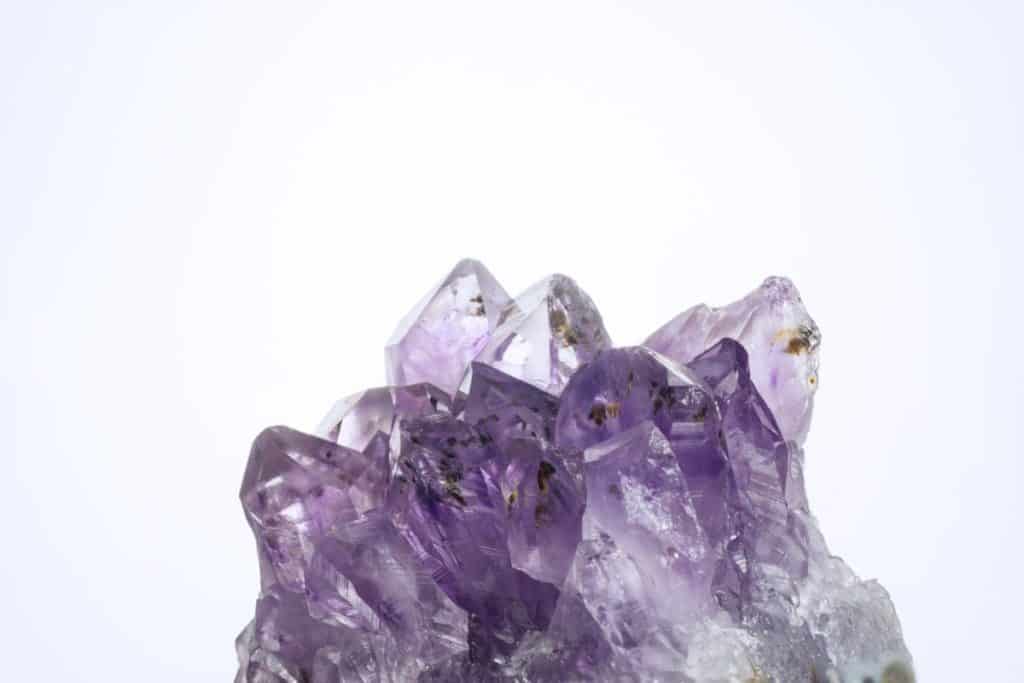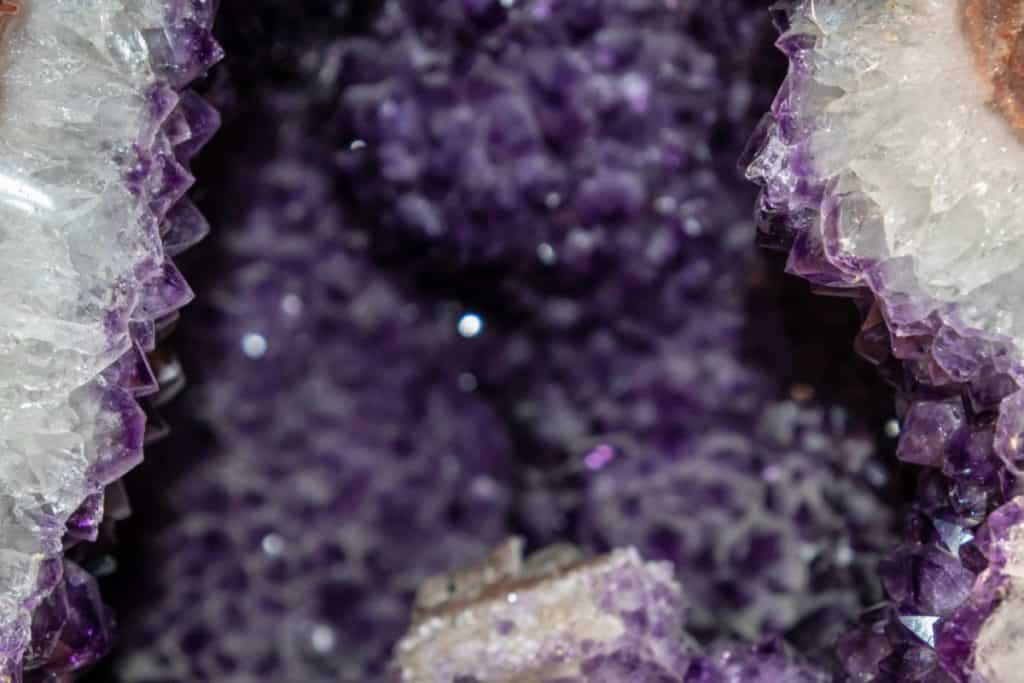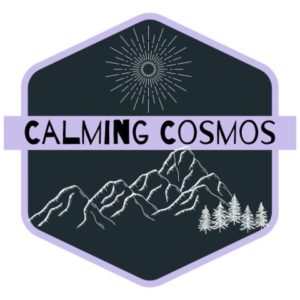When it comes to crystals, the Amethyst has got to be my personal favourite stone.
Its beautiful purple shimmering shade truly has the power to enchant and lighten up my spirits at any given time.
I’ve got quite a few of these precious stones lingering around my house in all sorts of shapes and sizes.
Looking at the beauty and uniqueness of each stone made me wonder how much amethyst crystals, clusters and geodes are actually worth. This is what I’ve found out.
The value of an amethyst is dependent on the depth of its color, quality and size. The darker the shade of purple, the more it’s worth. Prices can range from as little as a few dollars up to thousands of dollars, depending on its unique properties.


Table of Contents
How Much Is Amethyst Worth Per Kilo?
As mentioned earlier, the price of amethyst heavily depends on specific qualities of the stone, such as the depth of its purple color.
When Amethyst crystals, clusters or geodes are purchased in large quantities directly from the mines where they have been harvested, the price per kilo will generally range from between $10,- and $100,- dollars.
The difference in price per kilo (or pound) will be dependent on which quality category they’ve been assigned to.

When you’re interested in buying A-quality amethysts, you can best assume your crystals to be on the more expensive side; around $100,- dollars per kilo.
Whereas amethyst stones with lower category qualities (based on for example color or condition), will be available for much lower prices.
Large amethyst geodes of great quality can easily be sold for thousands of dollars, mostly due to their impressive size and weight.
An (extremely) large amethyst geode of around 300 pounds for example can easily cost around $14.000 dollars, where retail price might go up to $20.000 or more.
What Color Amethyst Is Most Valuable?
Purple is the most valuable amethyst color.
Amethyst colors can vary between a very light shade of purple to a deep reddish kind of purple.
The most valuable type of amethyst purple is a deep color purple combined with red and blue flashes and without visual color zoning.
Color zoning is what happens when there is an uneven distribution of color.
Is Amethyst Rare?
Although amethyst is an extremely beautiful type of crystal stone, it is not actually considered rare anymore.
When large quantities of amethyst were discovered in Brazil during the 19th century, the stone slowly lost its scarcity status.
As amethyst mines were found more and more across the globe in different areas, the price automatically went down as a result of the high supply.
Even though amethyst is generally not considered a rare type of crystal, amethysts with a darker colored shade of purple do still hold significantly more value than its lighter purple colored variants.
Also, extremely large amethyst geodes are not very common to come across so they should be considered at least quite exceptional.
Still, beauty is in the eye of the beholder. So even though the stone itself might not be considered rare, they still are attractive to a lot of people and besides being popular for home decoration, possess great healing qualities to benefit from.
If you happen to find an amethyst like the guys in the video below though, you can be quite sure you’ve come across something truly special!
How Can You Easily Tell If An Amethyst Stone Is Real Or Fake?
There are a lot of amethysts available on the crystal market nowadays, and sometimes it can be quite hard to tell whether they are real or fake, especially when you are far from being a crystal expert.
Luckily, there are however a few handy tricks and nifty methods you can use to be relatively sure whether you actually are in company of a real amethyst stone.
- Temperature: as rocks have low conductivity and high thermal mass, when holding the crystal stone in your hand, it should feel cold as the stone material ‘absorbs’ the warmth of your hand. This can be a great gauge to know whether your amethyst stone is real. If you hold the stone in your hand and it warms up immediately, you can be sure you’ve stumbled across a real fake one as this stone is most probably made of glass of some sort of synthetic material!
- Bubbles or cracks: Another way to check whether you possess a real or fake amethyst is to take a closer look at the stone and notice whether you can see air bubbles inside the stone. If you see small air bubbles then you can be sure your amethyst is made of some sort of glass or plastic. A real stone will never show bubbles. If the stone shows minor cracks instead, then this would be a great sign of its authenticity. Real amethyst stones will always be at least a little imperfect as they are created within a natural environment with a great amount of forceful pressure around them which will automatically result in at least a few cracks showing.
- Price: When you find an amethyst stone with a price tag that’s almost too good to be true, you can be sure to count on the fact that the price is indeed too good to be true. Although amethysts certainly aren’t the most expensive stone out there on the market, and quite frankly actually pretty affordable for the majority of people, you should be putting up some questions marks when coming across an Amethyst stone costing just a couple of cents (and on top of that will amazingly be send to you from the other side of the world without any additional shipping costs as well.. if you know what I mean!)
- Hardness: Amethyst stones have the ability to scratch a piece of glass without the stone being left with any damage. In order to know whether your amethyst is real, you can scratch a piece of glass with the stone which in turn should leave a white mark on the glass. Your stone should stay in the same condition after having scratched the glass.
- Washing: When you give your amethyst stone a nice shower, you shouldn’t find yourself having purple colored hands afterwards. If this happens you can be absolutely sure your beloved stone is as fake as a three dollar bill! However, even if your amethyst does pass the shower test, this doesn’t make the stone automatically real. You should still use some of the others methods mentioned above to be sure whether your amethyst stone is real or fake.
If you’re looking for a beautiful Amethyst that you can be sure of is authentic, here I will share some of my personal recommendations:
- Deep purple amethyst crystal cluster
- Raw Amethyst cluster with giftbox included
- Uruguayan Amethyst cluster including a Selenite wand
- Amethyst Cathedral Geode AAA Quality
Which Country Has The Best Quality Amethyst?
The majority of amethyst stones which are harvested worldwide come from big crystal mines across South America and Africa.
To be more specific; Brazil, Uruguay and Zambia.
The country that is known to have the absolute best quality Amethyst stones in general is Uruguay, as the most dark purple colored amethyst stones are found in the Uruguayan local mines.
Although Uruguay is known to be a truly outstanding source for great Amethysts, countries like Brazil and Zambia can without a doubt supply high quality crystals for your needs as they absolutely offer outstanding masterpieces as well.
Where amethysts from South America tend to be larger in size, Zambia is known to offer smaller yet even better quality colored stones, it all depends on what type of amethyst you are looking for.
Just take a look at these amazing tumbled amethyst stones from Brazil for example, great for home decoration purposes but also small enough to carry with you wherever you decide to go.
